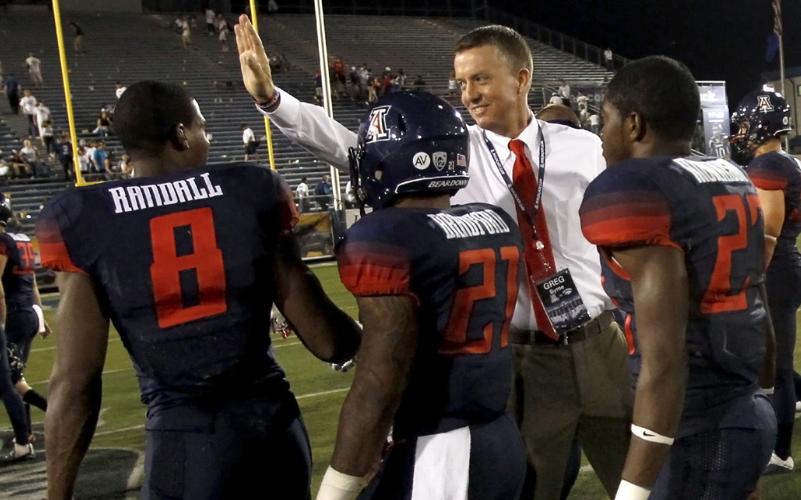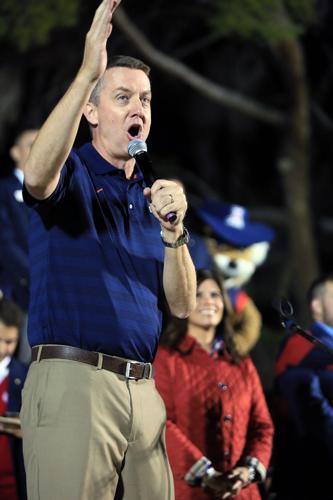As dawn broke Saturday morning in Tuscaloosa, Ala., Greg Byrne pulled a cap low on his head and began a 90-minute walking tour of the University of Alabama campus.
He was accompanied by one of the most powerful men in Alabama, Finis E. “Fess” St. John IV, a third-generation Birmingham-area attorney and member of the Alabama Board of Trustees.
“I wasn’t attempting to avoid being recognized,” Byrne said Monday afternoon in his office at McKale Center. “It was early in the morning and chilly outside.”
It was a power walk like few others in Byrne’s 45 years.
He visited all of the Crimson Tide landmarks: the Denny Chimes, the Woods Quad and Gorgas Library. Twelve hours earlier, Byrne and his wife, Regina, were dinner guests of sainted Alabama football coach Nick Saban and his wife, Terry.
“It was awesome,” Byrne says.
A month earlier, while in New York City for the National Football Foundation and College Hall of Fame banquet, Byrne was contacted by representatives of Alabama president Stuart R. Bell. Byrne wasn’t pursing a job. In fact, he recently purchased a home at Skyline Country Club and was waiting for renovations to be completed to expedite the move.
“I wasn’t looking for a job,” he says. “I have been ‘all-in’ on Arizona from the day I got here.”
Last week, while in Tampa for a meeting of the National Association of Collegiate Directors of Athletics— Byrne is the NACDA’s third vice-president — he agreed to fly to Tuscaloosa on a Crimson Tide jet and meet with Saban, Bell and St. John.
He accepted the job Saturday night.
By Sunday at noon Alabama’s next athletic director was back in Tucson. But Byrne didn’t go home and pack. He went to McKale Center to watch Arizona’s women’s basketball team play Washington State.
“I sat alone in a corner,” he says, his voice breaking with emotion. “I just love Adia. …”
As Byrne discussed the first season of coach Adia Barnes, he retrieved a box of Kleenex from his desk. He stopped about 30 seconds to compose himself.
“Regina always told me I’d cry at the grand opening of a Safeway,” he said with a smile. Over the next 40 minutes, reflecting on his 6½ years in Tucson, Byrne stopped three times to apply Kleenex and dab away tears.
By noon Monday, more than 280 messages had stacked up on his phone. He scheduled an early Tuesday staff meeting so he can say goodbye in person, one by one.
Let’s hope he stocked up on extra Kleenex.
“It’s hard to believe there’s an athletic director anywhere who did a better job for his university than Greg did for us,” Arizona basketball coach Sean Miller said.
Whatever Alabama is to pay Byrne — it’s probably about $1 million more than the $700,000 he was paid at Arizona — it’s difficult to put a value on his years at Arizona.
“He’s bright and he’s transparent and he did a great job there,” said iconic Arizona AD Cedric Dempsey, the man who persuaded Byrne to leave Starkville, Mississippi, in 2010 and become the seventh AD in UA history. “He’ll be hard to replace.”
Byrne became the most untraditional athletic director in Pac-12 history. He didn’t sit in a bunker, count pennies and balance budgets. He insisted on getting to know each of the school’s 500 student-athletes on a first-name basis, one by one. Who does that?
If you want to get him to reach for a Kleenex, ask him about the night he toured the upper deck on the east side of Arizona Stadium, introducing himself to those in the cheap seats.
“Some of those people could only afford to buy two $10 tickets to one game a year,” he remembers. “I loved talking to them. I really cared. I have a lot of weaknesses, but I’m not a phony.”
Byrne worked all sides of the UA family. He was a dinner companion of Hollywood producer Scott Stuber, flew to Florida to golf with Ryder Cup captain Jim Furyk and wasn’t camera shy when photographers focused on him sitting with actor Greg Kinnear.
That was a strength. He created a bond with those in the cheap seats and with those who produced “You, Me and Dupree.” Over time, you, me and Dupree became part of Byrne’s extended family.
For the past 6½ years, Arizona’s athletic department enjoyed more financial growth and outside attention than at any time in history. It was an image-changer. Byrne orchestrated all of it, exchanging Twitter messages with strangers, declaring Phoenix to be “Wildcat Country,” and raising more than $140 million to build a better football stadium, spruce up a state-of-the-art basketball arena and get the word out.
Not all of it worked. This isn’t Alabama.
The UA’s swimming program, once among the nation’s three or four powerhouses, imploded when Byrne hired the wrong head coach. The men’s golf program, once a threat to win the NCAA title year after year, has bottomed out. The man he hired to run Arizona’s football operation, Rich Rodriguez, is in the struggle of his coaching lifetime.
But those things are predictable; there are limitations at Arizona and its $85 million athletic budget that Byrne won’t encounter at Alabama, which has a budget of about $190 million.
His departure isn’t unlike Dempsey’s decision to leave Arizona in 1994 to become executive director of the NCAA. The right people notice when you do a good job.
“Greg’s reputation in the industry is very strong,” Dempsey says. “I thought it would be hard to keep him much longer.”
With a Kleenex in hand, Byrne talked about the sleepless nights he’s spent and the importance of his successor remaking Arizona Stadium, something that could cost in excess of $100 million.
“This is a special place,” he says. “I put every bit of myself into this job until, frankly, I ran low on energy. Before we move to Alabama, I’m going to take a month off to recharge. I’ve never done anything like that.”





